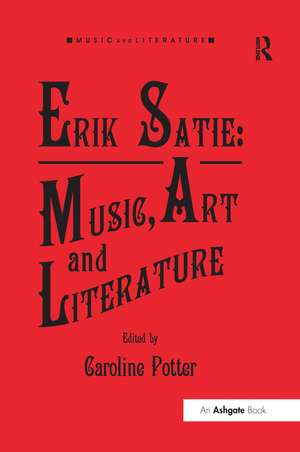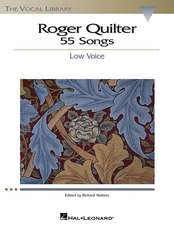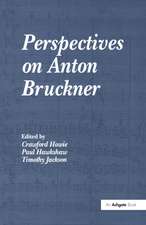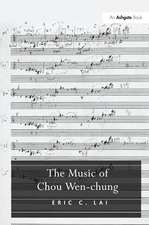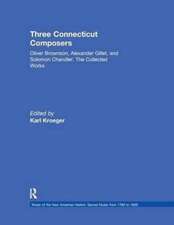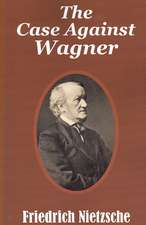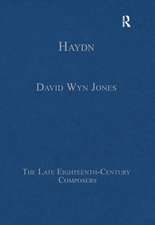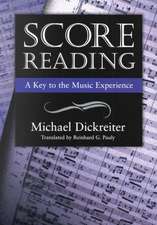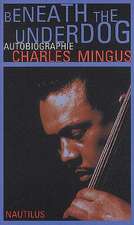Erik Satie: Music, Art and Literature: Music and Literature
Editat de Caroline Potteren Limba Engleză Paperback – 3 oct 2016
Preț: 324.16 lei
Preț vechi: 416.92 lei
-22% Nou
Puncte Express: 486
Preț estimativ în valută:
62.05€ • 67.42$ • 52.15£
62.05€ • 67.42$ • 52.15£
Carte tipărită la comandă
Livrare economică 21 aprilie-05 mai
Preluare comenzi: 021 569.72.76
Specificații
ISBN-13: 9781138247697
ISBN-10: 1138247693
Pagini: 368
Dimensiuni: 156 x 234 x 26 mm
Greutate: 0.45 kg
Ediția:1
Editura: Taylor & Francis
Colecția Routledge
Seria Music and Literature
Locul publicării:Oxford, United Kingdom
ISBN-10: 1138247693
Pagini: 368
Dimensiuni: 156 x 234 x 26 mm
Greutate: 0.45 kg
Ediția:1
Editura: Taylor & Francis
Colecția Routledge
Seria Music and Literature
Locul publicării:Oxford, United Kingdom
Notă biografică
Caroline Potter is Reader in Music at Kingston University, London. A graduate in both French and music, she obtained a PhD at Liverpool University in 1995 for her thesis on the music of Henri Dutilleux and has published widely on French music since Debussy.
Recenzii
A Yankee Book Peddler US Core Title for 2013
'This book is a much-needed addition to the rather sparse offerings in English concerning the innovative and eccentric composer Erik Satie (1866-1925)...most of Satie’s music is heard infrequently and is very little known to the concert-going public...Summing Up: Highly recommended. All readers.' Choice
'Piano works by the French composer Erik Satie (1866-1925) are everywhere... This collection of well-documented articles clarifies that appeal. Erik Satie: Music, Art and Literature usefully demonstrates how Satie’s originality and sometimes ornery eccentricity helped fuel his lasting reputation as a musical genius.' International Piano Magazine
'... collection of nine essays and a transcribed conversation that between them explore many aspects of the composer’s creativity and legacy, as well as his place in French cultural life during the late nineteenth and early twentieth centuries. Taken together, they demonstrate convincingly how far-sighted Satie was during his lifetime. They show how far-reaching his posthumous influence has been on multi-media movements from Dadaism to Fluxus, and why post-Second World War experimental composers such as John Cage (who felt alienated from the ultra-strict serialism that dominated European avant-garde music in the 1950s and 1960s) said of him that it’s not a question of Satie’s relevance. He’s indispensable.’ Modernism/Modernity
'By emphasizing the centrality of Satie’s interart aesthetic, all of the essays in this volume contribute to a better understanding of Satie’s music, including some of its most inscrutable elements. These essays are, moreover, distinguished by their use of archival materials, including Satie’s correspondence and manuscripts.' Contemporary French Civilization
'This book is a much-needed addition to the rather sparse offerings in English concerning the innovative and eccentric composer Erik Satie (1866-1925)...most of Satie’s music is heard infrequently and is very little known to the concert-going public...Summing Up: Highly recommended. All readers.' Choice
'Piano works by the French composer Erik Satie (1866-1925) are everywhere... This collection of well-documented articles clarifies that appeal. Erik Satie: Music, Art and Literature usefully demonstrates how Satie’s originality and sometimes ornery eccentricity helped fuel his lasting reputation as a musical genius.' International Piano Magazine
'... collection of nine essays and a transcribed conversation that between them explore many aspects of the composer’s creativity and legacy, as well as his place in French cultural life during the late nineteenth and early twentieth centuries. Taken together, they demonstrate convincingly how far-sighted Satie was during his lifetime. They show how far-reaching his posthumous influence has been on multi-media movements from Dadaism to Fluxus, and why post-Second World War experimental composers such as John Cage (who felt alienated from the ultra-strict serialism that dominated European avant-garde music in the 1950s and 1960s) said of him that it’s not a question of Satie’s relevance. He’s indispensable.’ Modernism/Modernity
'By emphasizing the centrality of Satie’s interart aesthetic, all of the essays in this volume contribute to a better understanding of Satie’s music, including some of its most inscrutable elements. These essays are, moreover, distinguished by their use of archival materials, including Satie’s correspondence and manuscripts.' Contemporary French Civilization
Cuprins
1: Satie's Personal and Musical Logic; 2: Satie and the Meaning of the Comic; 3: Satie's Rose-Croix Piano Works; 4: Satie as Poet, Playwright and Composer; 5: ‘The Only Musician with Eyes': Erik Satie and Visual Art; 6: Exploring Interart Dialogue in Erik Satie's Sports et divertissements (1914/1922); 7: Parade: ballet réaliste; 8: Collaborative Works in Satie's Last Years; 9: History, Homeopathy and the Spiritual Impulse in the Post-war Reception of Satie: Cage, Higgins, Beuys; 10: After Satie: Howard Skempton in Conversation with Caroline Potter
Descriere
Exploring the many aspects of Erik Satie's creativity, the contributors to this edited collection examine his philosophy and psychology revealed through his music; Satie's interest and participation in visual and literary artistic media; and his collaborations with other artists. His artistic activity, during a tumultuous time in the Parisian art world, situates him in an especially exciting period, and his friendships with Debussy, Stravinsky and others place Satie at the centre of French musical life. This book is essential reading for anyone interested in the French musical and cultural scene of the late nineteenth and early twentieth centuries.
